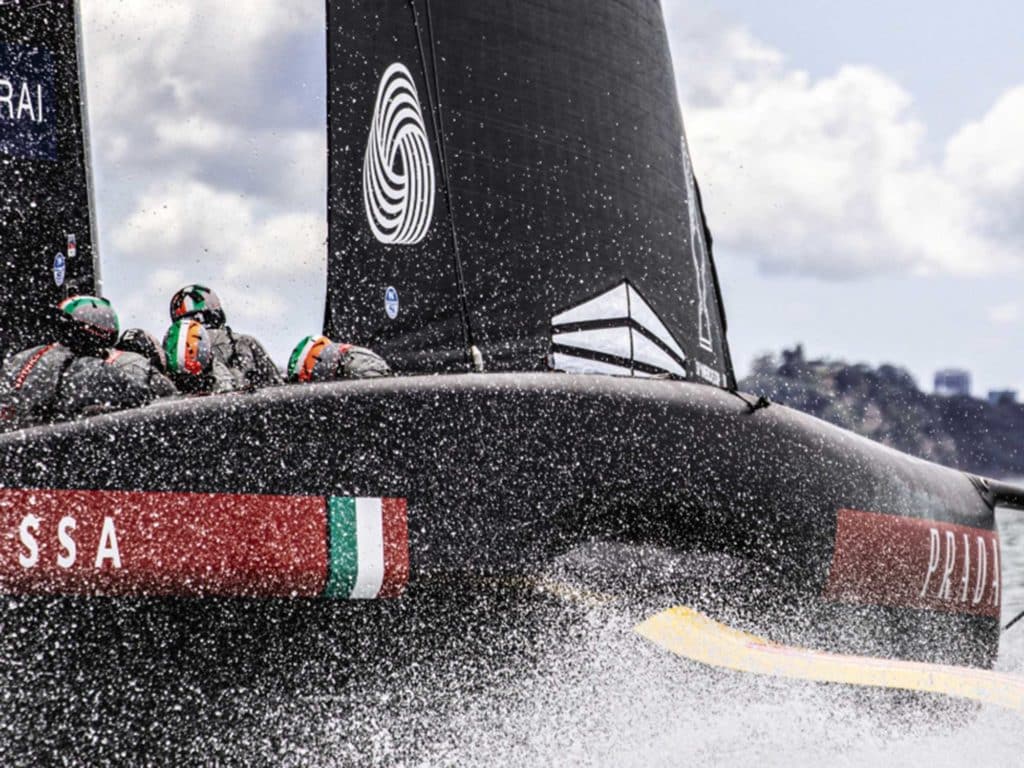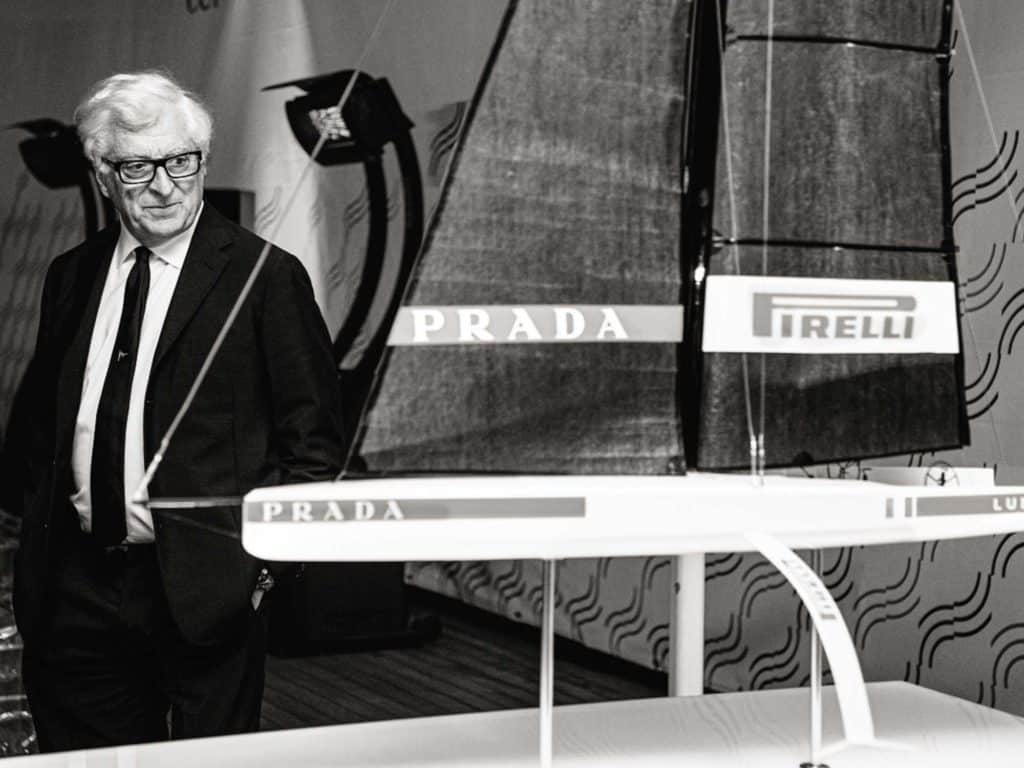
Four years of a typical America’s Cup campaign is usually enough to convince any lustful billionaire of the insanity of the commitment—financially and emotionally. But two decades? And never a win? That’s unthinkable. Yet, for Patrizio Bertelli, the Italian fashion magnate and principal of Luna Rossa Prada Pirelli Team, it’s hard to imagine living without the relentless pursuit of the Cup and the satisfaction of someday having “Luna Rossa” etched into glimmering silver base of the Auld Mug.
“The beauty and the ugliness of the America’s Cup is that there is no rationale, no logic, no perfection,” Bertelli once told America’s Cup scribe and historian Bob Fisher. “The America’s Cup should be the spearhead of the whole sailing movement, the whole sailing world, where people participate because it is gratifying for them. It is interesting and exciting for them to be involved.”
Only Bertelli himself can speak of the true toll of his devotion to the Cup, an obsession that started in Milan in 1997 when he and yacht designer German Frers committed to challenging Team New Zealand, the Black Magic squad that dominated in San Diego and would defend in Auckland for the first time. Three years later, the Luna Rossa team arrived in style, with its signature sleek black boats and Prada Red accent stripes. They would win the Louis Vuitton Cup Challenger Series but ultimately fall to the Kiwi sword without ever winning a single race in the America’s Cup Match.
History repeated itself in 2007, in Auckland again, where Bertelli’s challenge advanced only to the semifinals. That was the 31st America’s Cup, where Alinghi—with defector Russell Coutts at helm—upset the New Zealand defense as it struggled with its inferior yacht.
Despite three failed attempts, Bertelli refused to bow out and challenged again when Alinghi held its defense in nearby Valencia, Spain, in 2007. This was the banner year of the IACC fleet, with 11 teams—a robust turnout for the Cup. This was also the year of the arrival of one Jimmy Spithill, the red-headed and freckled young match-racing star from Australia. With Spithill on the wheel, the Italians dismissed Oracle Team USA 5-to-1 in the Louis Vuitton semifinals before Team New Zealand returned the favor five to zip.
“We always had the best design teams, but they were a bit cautious,” Bertelli says. “When the times were right, we looked at the others who were experimenting with their own original ideas. We were not unhappy with the design performance. The results were good, but we never had that little something that makes you win the America’s Cup.”
While Alinghi’s Ernesto Bertarelli and Oracle Team USA’s Larry Ellison moved on to their 33rd America’s Cup Deed of Gift multihull shenanigans, Bertelli happily watched from the sidelines and kept the team active with other grand-prix sailing endeavors as a demonstration of his commitment to foster native sailing talent.
Late to the party of Ellison’s San Francisco’s AC72 foiling catamaran match, the Italians in their slick silver boat and skin suits were never truly competitive, and fell easily to Emirates Team New Zealand in the depleted challenger sail-off. In San Fran, there was no love lost between the Italians and the Defender, which went on to beat Emirates Team New Zealand in the Cup’s greatest comeback performance.
RELATED: Emirates Team New Zealand: The 36th Defense
Bad blood with the American defender soon boiled over in the lead-up to the 35th America’s Cup in Bermuda. Oracle Team USA unilaterally changed the regatta’s guiding document—and the type of boat—well into the design cycle. What was supposed to be a 62-foot catamaran was changed to 48 (which became the AC50), and Bertelli—for good reason—was apoplectic over the audacity of the Americans to change the game. So he quit, and it was the first time a Challenger had ever walked away—not for lack of finances but on principle.
“I didn’t quite understand the rationale behind these changes,” Bertelli told Fisher at the time. “The only thing that was pretty apparent was that we had been working, and we had been sailing for one year by then, and many of our designs and many of our innovations would eventually be useless. Luna Rossa leaving the Cup was not just my decision. It was the decision that the whole team took together because they were really disgusted by what happened.”
Had they continued, they would have most certainly have been in Bermuda, directed by the team’s current and natural-born leader, Max Sirena. But they sat it out and hoped for the best. “What I can tell you is that if Oracle wins again, you are not going to see the next Luna Rossa team,” Bertelli told Fisher when asked what it would take to resume his Cup crusade. “Is that clear enough?”
Those inside the Luna Rossa camp, and a few close to Bertelli, all say he was over the red moon when the New Zealanders easily dismissed Ellison’s team. He and the president of Sicily’s Circolo della Vela Sicilia, Agostino Randazzo, was at the ready, with challenge in hand.
There’s an Italian saying, Bertelli says, “which is, the more you eat, the more you have an appetite.”
Randazzo, having witnessed firsthand the incredible resiliency of the Kiwis after capsizing and practically destroying their boat—before going on to win—says the experience laid the foundation for his own desires to see the same outcome for Italy. “Looking straight into the eyes of [RNZYS] Commodore Steve Mair as I handed him my challenge,” he says, “I understood what it means to win the America’s Cup.”
With a cozy relationship with Grant Dalton and many of the New Zealand sailors, Bertelli was keen to claim the role of Challenger of Record this time, to have greater control of his team’s destiny and reestablish certain traditions that lured him to the Cup in the first place: integrity, technology and national teams. He wanted a monohull, and he got it with the AC75, a compromise of sorts.

“There are cycles,” Bertelli reasoned with Fisher in 2015. “The America’s Cup lives off cycles, and the catamaran actually started in 2007, so it is a whole 10-year cycle with the cats. We had the J Class in 1938 and then the 12 Metres, then the IACC, the catamarans in the AC72s. It might well be the time for another change. It happens in the history of the Cup. It is not us telling it; it is history telling us.”
In their role as Challenger of Record, and in close collaboration with the Defender, they took on responsibility and development of the AC75s foil arms, to be built by their own boatbuilder, Persico Marine, and assembled a first-class sailing team, including Oracle Team USA’s own Jimmy Spithill, the only true foreigner on the team, which is a point of pride. The rules require at least 20 percent of the racing crew be nationals of the competing club, but Luna Rossa pretty much went all-in: The team is predominantly Italian, and it’s the language spoken on the boat.
Despite being Ellison’s guy, Spithill’s relationship with the Bertelli was always amicable over the years following the 2007 campaign. There are few individuals on the planet with his Cup experience, so Spithill’s assignment as one of two primary helmsmen (sharing duties with Francesco Bruni) is one way to guarantee positive results for Bertelli’s sixth run as a Cup challenger. With Oracle, Spithill was always the face of the team, its press-conference punching bag and confident leader, but now that he’s folded into the Italian squad, he’s been able to focus ever sharper on the sailing and development of their race boats. He’s flanked with outstanding talent in the afterguard and trimmers, and the boat is powered by a young and hungry cast of handpicked “new generation” Italian sailors.
“Last time, I was really running the team and I enjoyed that, but I didn’t realize how much I really enjoy the sailing time,” Spithill said as he and his teammates were coming to grips with their test boat—appropriately named Quick & Dirty—off Cagliari. “You can get dragged away in so many ways, so it really is nice now to really be able to focus on the sailing, especially with a boat like this because we just don’t have much time. Everything’s developing at a very fast pace.”
Equipment started breaking at a fast pace as well, however. In the early days of their first AC75, they suffered one setback after another, including a dismasting, but the ultimate shock to the campaign was the COVID-19 pandemic, which gripped Europe, and particularly Italy, in the spring. The construction of their second boat ground to a halt, as did production of the foil arms for them and other teams. Next came the countrywide lockdown and the cancellation of the first scheduled America’s Cup World Series event in Cagliari, which was going to be their big show. The team went as far as modifying the boat with engines, in order to reduce the number of grinders on the boat, which allowed them to continue some semblance of training and development. It was also a tumultuous and uncertain time for the team’s back of house, marked by Bertelli’s arrival at the base one day to personally flush the staff in what was described by one dismissed personnel as Mr. Bertelli’s “Red Wedding.”
While awaiting the lift of the lockdown, however, the sailing team doubled down in its simulator sessions and adapted its fitness regime, with the sailors spending long hours in grinding isolation and carrying rocks across the seabed.
“In the simulator, we go until we’re brain-dead,” Spithill said. “If you make a mistake on the water, you lose so much, but on the simulator, we can just stop and do it again, setting up different scenarios.”
The British challenger, INEOS Team UK, which had set up shop in Cagliari ahead of the world series regatta, eventually packed up and went home, leaving the Italians to their own, but not without noting the impressive display of boathandling and speed of the Luna Rossa Prada Pirelli Team. The Italians’ hull design was akin to that of the New Zealanders’, with a noticeable skeg running the length of its underbody, a trait every team would eventually adapt for their second-generation boats.
The Italians certainly had everyone’s attention again, as Sirena’s wife smashed the bubbly across the bow of their second AC75 in Auckland in November. Luna Rossa was the last AC75 to arrive by Antonov cargo plane, and while late to the party again, Spithill admitted that there was much work to do to catch up with Defender and challengers alike.
“I think we’ll be competitive,” he told the media on launch day, “but it depends on gettingg the boat to 100 percent. It’s about who develops best from now on.”
Bertelli thanked the respective build and sailing teams, praising those who “have worked day and night, with no distinction of roles, to be on deadline and ready to launch. We will get our first impressions, which I am sure will live up to expectations.”
Those expectations are, of course, to win, and there is a sense —whether Bertelli will admit it or not—that it’s now or never for Luna Rossa. The team motto is “Challenger for now,” and unless he’s sitting in the Defender’s throne next time around, the red moon may never again rise over the Cup.









